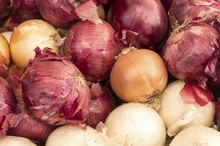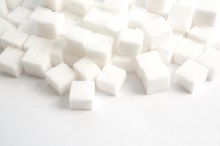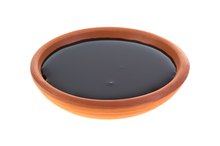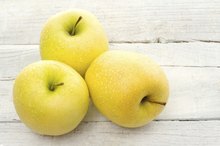Carbohydrates and Fiber in Onions
With more than 500 varieties, onions are among the top 10 vegetable crops in the world. Color is only one of the characteristics that distinguish different varieties of onions, which are grouped broadly into fresh and storage categories. All onion varieties contain similar concentrations of carbs, including sugars and fiber. The taste of different onions depends on the sulfur, sugar and water content.
Types of Carbs
All carbohydrates consist of sugar, or saccharide, molecules in different structural formations. Single or paired saccharide molecules have the common designation of "sugars." Glucose, fructose and lactose are examples of sugars. Starches are long chains of glucose molecules that break down into sugar in your intestines. Fiber is a third type of carb that differs significantly from the other two because your body cannot digest fiber into its component sugar molecules. Fiber passes through your digestive system intact. Onions contain carbs in the form of sugars and fiber; they do not contain starch.
- All carbohydrates consist of sugar, or saccharide, molecules in different structural formations.
- Onions contain carbs in the form of sugars and fiber; they do not contain starch.
Sugars in Onions
The Effects of Onions on Cholesterol & Blood Sugar
Learn More
Onions contain the sugars glucose, fructose and sucrose. The presence of these sugars is why onions caramelize when you cook them slowly over low heat. Because sugars accumulate as onions mature, green onions, also known as spring onions, contain less sugar than mature onions. Yellow, red and white onions that you find at the market are mature onions. A cup of chopped, green onions contains approximately 2.3 g of sugar, compared with a cup of chopped, mature onions, with 6.8 g of sugar. Like other nonstarchy vegetables, onions will not cause a sudden rise in your blood sugar levels because the fiber content slows sugar digestion and absorption.
- Onions contain the sugars glucose, fructose and sucrose.
- The presence of these sugars is why onions caramelize when you cook them slowly over low heat.
Fiber in Onions
Onions are a good source of dietary fiber, especially soluble fiber. This type of fiber reacts with water and forms a gel, which absorbs cholesterol in your intestines. The fiber-cholesterol complex is excreted in your stool, helping to lower your blood cholesterol level. A cup of chopped green or mature onions contains approximately 2.7 g of fiber.
- Onions are a good source of dietary fiber, especially soluble fiber.
- The fiber-cholesterol complex is excreted in your stool, helping to lower your blood cholesterol level.
Sweet Onions
Physical Characteristics of Glucose
Learn More
Sweet onion varieties, such as:
- Walla Walla
- Vidalia
- Maui
- have a milder
- sweeter flavor than other onions
- but they do not contain significantly more carbs
Sulfur-containing chemicals impart onions with their pungent, hot flavor 2. Sweet onions contain a lower concentration of these chemicals and have more water than other onion varieties, resulting in a more mild flavor. The thin skin on sweet onions also distinguishes them from yellow, white and red storage onions. Unlike these common onions, which can be stored at room temperature, sweet onions are best kept in your refrigerator.
- Sweet onion varieties, such as: * Walla Walla
* Vidalia
* Maui
* have a milder
* sweeter flavor than other onions
* but they do not contain significantly more carbs Sulfur-containing chemicals impart onions with their pungent, hot flavor 2.
Related Articles
References
- Centers for Disease Control and Prevention: Onion
- USDA Agricultural Research Service: Onions with a Nutritional—Not Pungent—Punch
- "Onions and Allied Crops: Biochemistry, Food Science, and Minor Crops"; James Brewster et al; 1994
- Onions, raw. FoodData Central. U.S. Department of Agriculture. Published April 1, 2019.
- Anderson GH, Soeandy CD, Smith CE. White vegetables: Glycemia and satiety. Adv Nutr. 2013;4(3):356S-67S. doi:10.3945/an.112.003509
- Exploring aromatics. Academy of Nutrition and Dietetics. Updated 2020.
- Dabeek WM, Marra MV. Dietary quercetin and kaempferol: Bioavailability and potential cardiovascular-related bioactivity in humans. Nutrients. 2019;11(10). doi:10.3390/nu11102288
- Puccinelli MT, Stan SD. Dietary bioactive diallyl trisulfide in cancer prevention and treatment. Int J Mol Sci. 2017;18(8). doi:10.3390/ijms18081645
- Marrelli M, Amodeo V, Statti G, Conforti F. Biological properties and bioactive components of Allium cepa L.: Focus on potential benefits in the treatment of obesity and related comorbidities. Molecules. 2018;24(1). doi:10.3390/molecules24010119
- Chae MR, Kang SJ, Lee KP, et al. Onion (Allium cepa L.) peel extract (OPE) regulates human sperm motility via protein kinase C-mediated activation of the human voltage-gated proton channel. Andrology. 2017;5(5):979-989. doi:10.1111/andr.12406
- Smith AP, Sutherland D, Hewlett P. An investigation of the acute effects of oligofructose-enriched inulin on subjective wellbeing, mood and cognitive performance. Nutrients. 2015;7(11):8887-96. doi:10.3390/nu7115441
- Albanesi M, Pasculli C, Giliberti L, et al. Immunological characterization of onion (Allium cepa) allergy. Postepy Dermatol Alergol. 2019;36(1):98-103. doi:10.5114/ada.2019.82829
- Cooking with onions without crying. University of Nebraska-Lincoln. Updated 2020.
- What is the low FODMAP diet?. Academy of Nutrition and Dietetics. Updated 2019.
- Onions. RxList. Updated 2019.
- Shock CC, Cheatham NE, Harden JL, Mahony, AC, Shock BM. Types of onions and varieties. Oregon State University. College of Agricultural Sciences. Updated 2020.
- Dowdy S. Stored properly Vidalia onions can still be around this winter. University of Georgia. College of Agriculture and Environmental Science. Updated 2019.
Writer Bio
Dr. St. John is a medical writer and editor with more than 15 years experience in the field. She is a former medical officer for the Centers for Disease Control and Prevention.









